Intel Beast Canyon NUC Review: Desktop Tiger Lake Debuts in SFF Gaming Powerhouse
by Ganesh T S on July 29, 2021 9:00 AM EST- Posted in
- Systems
- Intel
- NUC
- Tiger Lake
- NUC11
- Beast Canyon
BAPCo SYSmark 25
The Intel NUC11BTMi9 (Beast Canyon) was evaluated using our Fall 2018 test suite for small-form factor PCs. In the first section, we will be looking at SYSmark 25.
BAPCo's SYSmark 25 is an application-based benchmark that uses real-world applications to replay usage patterns of business users in the areas of productivity, creativity, and responsiveness. The 'Productivity Scenario' covers office-centric activities including word processing, spreadsheet usage, financial analysis, software development, application installation, file compression, and e-mail management. The 'Creativity Scenario' represents media-centric activities such as digital photo processing, AI and ML for face recognition in photos and videos for the purpose of content creation, etc. The 'Responsiveness Scenario' evaluates the ability of the system to react in a quick manner to user inputs in areas such as application and file launches, web browsing, and multi-tasking.
Scores are meant to be compared against a reference desktop (the SYSmark 25 calibration system, a Lenovo Thinkcenter M720q with a Core i5-8500T and 8GB of DDR4 memory to go with a 256GB M.2 NVMe SSD). The calibration system scores 1000 in each of the scenarios. A score of, say, 2000, would imply that the system under test is twice as fast as the reference system.
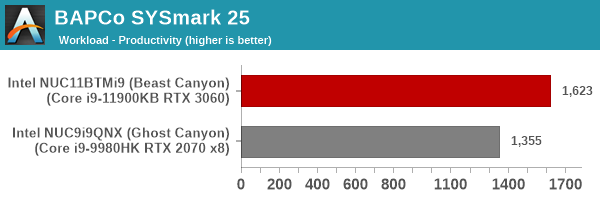
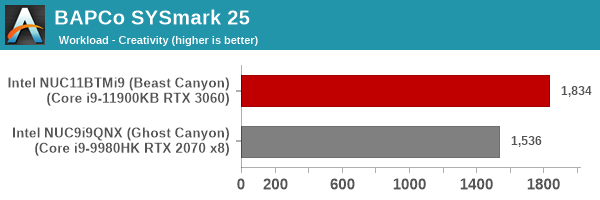
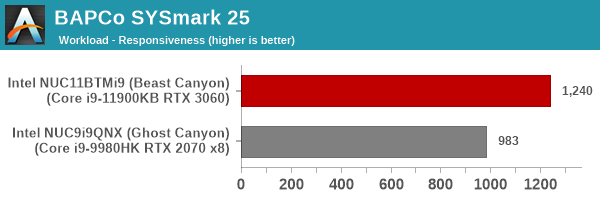
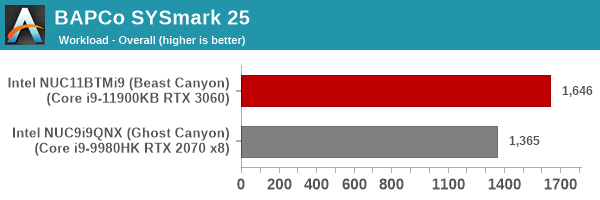
SYSmark 25 also adds energy measurement to the mix. A high score in the SYSmark benchmarks might be nice to have, but, potential customers also need to determine the balance between power consumption and the efficiency of the system. For example, in the average office scenario, it might not be worth purchasing a noisy and power-hungry PC just because it ends up with a 2000 score in the SYSmark 2014 SE benchmarks. In order to provide a balanced perspective, SYSmark 25 also allows vendors and decision makers to track the energy consumption during each workload. In the graphs below, we find the total energy consumed by the PC under test for a single iteration of each SYSmark 25 workload. For reference, the calibration system consumes 8.88 Wh for productivity, 10.81 Wh for creativity, and 19.69 Wh overall.
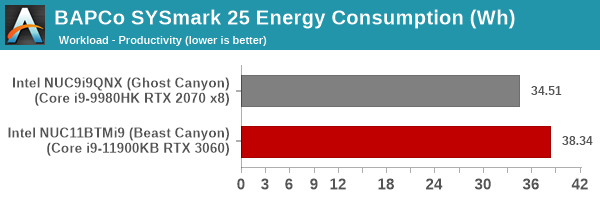
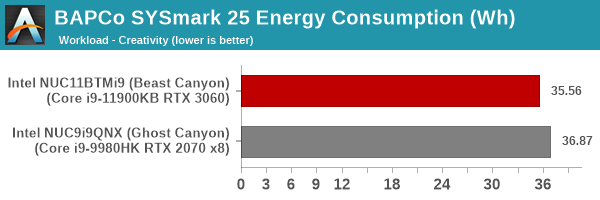
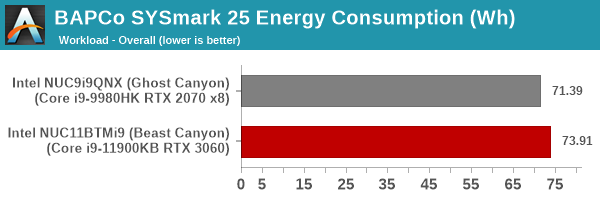
The Beast Canyon outscores the Ghost Canyon by around 20%. The increase in energy consumption is miniscule.










84 Comments
View All Comments
meacupla - Friday, July 30, 2021 - link
Of all the parts that are likely to fail prematurely in a PC, the least likely is the CPU, followed by the mobo.For mobo failures, it's either DOA, or after 5yrs+. By the time you hit 5yrs+, there is a high likelyhood you can't find a replacement ITX mobo anyways, thus forcing you to buy both CPU+mobo, and potentially RAM.
I mean, if you are that worried about premature failure outside of warranty, just buy a 3yr or 5yr extended warranty with the seller.
mode_13h - Monday, August 2, 2021 - link
In terms of part replaceability, I'd worry that the form factor would be a big impediment to part selection. That'd be the main rationale for preferring a standard desktop.The main reason I'd buy this machine is that it's the only way to get a Tiger Lake-H, outside of laptop.
TheinsanegamerN - Thursday, July 29, 2021 - link
I see that cooling and all I can think of is *noise*meacupla - Friday, July 30, 2021 - link
From what I've seen in other reviews, it's very quiet, even at full load.Spunjji - Friday, July 30, 2021 - link
I really don't trust most reviewers' assessments of what is and it not quiet, sadly. It does look like it might be engineered well enough not to be a constant irritant, but that type of fan has a high noise floor and a relatively high pitch by default.meacupla - Friday, July 30, 2021 - link
Okay, well, you can go down your "I don't trust most reviewers" rabbit hole then.Oxford Guy - Wednesday, August 11, 2021 - link
I trust that this review’s comment about production BIOS fan noise is an example of tasteful understatement.willis936 - Friday, July 30, 2021 - link
You see 3x 120x25 mm fans and think "that's going to be loud"?alpha754293 - Thursday, July 29, 2021 - link
a) This is the formerly Sun Microsystems Penguin on steroids.(Add-in card based computers is nothing new. Google it.)
b) It would be interesting to see a time history trace/plot of the CPU frequency during the CPU stress test because I've found that the 100 mm x 100 mm generation of Intel NUCs - the CPUs were SEVERELY limited and would thermal throttle very quickly under full CPU load such that you weren't ever able to use said Intel NUCs to its fullest potential.
c) It's really a shame that AMD doesn't have something like this.
AdrianBc - Thursday, July 29, 2021 - link
The thermal behavior of the 100 mm x 100 mm NUCs has varied a lot from generation to generation, because they have used different coolers, some more efficient others less efficient, some noisier other less noisy.I have more than a dozen of different NUCs and I believe that the best coolers were in their 8th generation, i.e. 2018/2019, with Coffee Lake or Cannon Lake CPUs (Cannon Lake was of course a pathetic CPU, but they used the same good coolers like Coffee Lake).
Those 8th generation NUC coolers were practically silent in normal operation and they allowed in the i7 Cofee Lake model a power dissipation of 50 W for the first half minute then of 30 W forever, which was much better than any laptop that used the same CPU (e.g. Apple).
So with adequate coolers it is possible to have good performance even in the 100 mm x 100 mm (4 inch) size.